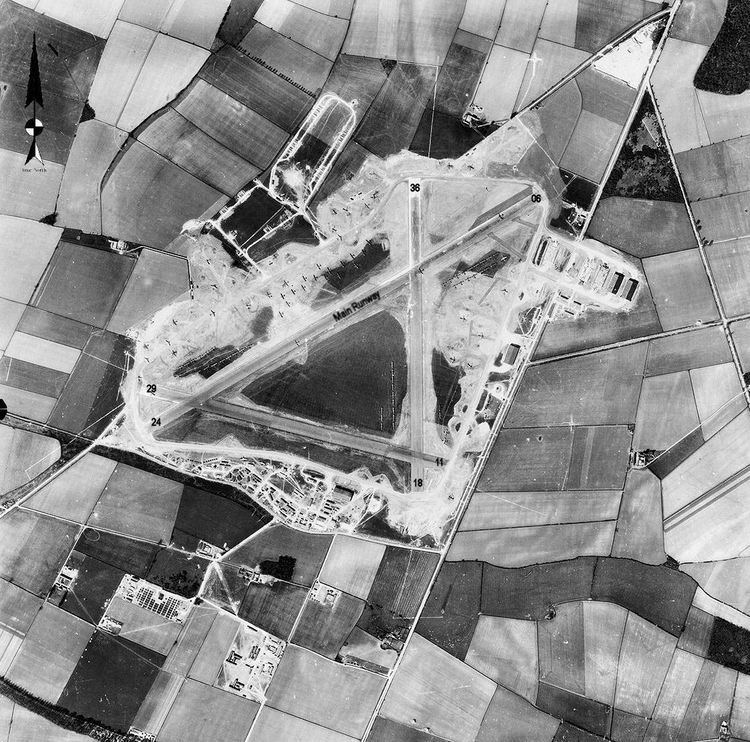In use 1938-1943;1944-Present Year built 1938 | Elevation 112 m Owner Ministry of Defence | |
 | ||
Code BH (World War II); BA (Current) Operator Royal Air Force
United States Army Air Forces Controlled by RAF Flying Training Command (1938-1943; 1945-1968)
Ninth Air Force (1944-1945)
Royal Air Force College (1969-Present) Battles/wars Second World War
Air Offensive, Europe 06/24 1,831 metres (6,007 ft) Asphalt Address Barkston, Grantham NG32 3PZ, UK | ||
Domino htr sprint raf barkston heath royal air force mini club
Royal Air Force Barkston Heath or RAF Barkston Heath (ICAO: EGYE) is a Royal Air Force station near Grantham, Lincolnshire, England.
Contents
- Domino htr sprint raf barkston heath royal air force mini club
- Firefly aerobatics at raf barkston heath
- History
- United States Army Air Forces use
- 61st Troop Carrier Group
- 349th Troop Carrier Group
- Royal Air Force use
- Other units
- Current units
- References
RAF Barkston Heath has the Naval and Army Elements of No. 3 Flying Training School RAF (3 FTS) which, for a period between approximately 1995-2010 operated the Slingsby T67M260 Firefly two-seat trainer. The school now operates the Grob Tutor T.1. A secondary role of RAF Barkston Heath is as a Relief Landing Ground for the flying training activities at RAF Cranwell.
3 FTS provides elementary flying training for Royal Navy and Army Air Corps students. The distinctive black and yellow Slingsby Firefly was a common sight above the skies of Lincolnshire until replaced by the somewhat quieter Grob Tutor.
Firefly aerobatics at raf barkston heath
History
At the time of its construction, Barkston Heath was intended for use by the RAF's No. 7 Group, in common with a number of other airfields in the Grantham area.
United States Army Air Forces use
In late 1943, Barkston Heath was made available to the United States Army Air Forces Ninth Air Force. It was earmarked for basing troop carrier units scheduled to be transferred from Sicily to participate in the forthcoming cross-Channel invasion, Operation "Overlord". During its time as a USAAF airfield, Barkston Heath was designated as USAAF station 483.
61st Troop Carrier Group
The first US personnel arrived on 13 February from Sciacca, Sicily, and most of their Douglas C-47 Skytrains on the 17th and 18th, although not all aircraft were in place until a month later. These new occupants were the 61st Troop Carrier Group with its components being:
The 61st TCG was part of the 52nd Troop Carrier Wing, IX Troop Carrier Command. The headquarters of the 61st Troop Carrier Group moved to an Advanced Landing Ground (ALG) at Abbeville (ALG B-92), France, on 13 March 1945, but its squadrons went to RAF Chipping Ongar from where they participated in Operation "Varsity" on 24 March carrying British paratroops who dropped near Wesel.
349th Troop Carrier Group
An increased demand for theatre air transport brought the 349th TCG from Baer Field Indiana in late March 1945, with its Curtiss C-46 Commando transports. Group headquarters was established at Barkston on 30 March, but the group only remained three weeks before moving to Rove/Amy, France, on 18 April.
The squadrons of the 349th TCG were coded as follows: the 23rd -08, 312th -9E, 313th -3F, and 314th -LY. It was assigned to the 52nd Troop Carrier Wing.
In May, a detachment of C-46s from this group returned to airlift British 1st Airborne Division troops to Norway.
Royal Air Force use
The USAAF returned control of the airfield to the Air Ministry in June 1945 when the war in Europe ended. Barkston Heath was used by No. 256 Maintenance Unit RAF and No. 2 Squadron RAF Regiment. From May 1948 it was assigned to RAF Cranwell as a relief landing ground, and this role continues today.
From 1983 to 1989 Barkston was home to 'A' Flight 25 Squadron (with Bristol Bloodhound surface-to-air missiles) when they returned from RAF Bruggen in Germany. For a while Barkston was the home of Red Dragon flight delivering Prince Charles's basic flight training.
Today, Barkston Heath remains a largely unspoilt Second World War airfield. It remains an active base, providing a home to both 703 Naval Air Squadron and 674 Squadron Army Air Corps who operate the Grob Tutor in a training role. The airfield was also used during the 1980s by a number of privately owned aircraft of various types, and for several years it has also been the venue for the British National Model Aircraft Championships. Because the aircraft used are relatively small, the runways have not needed to be lengthened, preserving the wartime layout. Consequently, many of the wartime loop dispersals survive, along with the T-2 hangars.
The current generation of training aircraft are operated by the No. 3 Flying Training School but provided by a civilian contractor, Babcock Aerospace, that also provides a significant proportion of the instructional staff, an Air Traffic Control service, plus engineering and support personnel. Other airfield services are provided by Serco.
On 11 July 2003, the airfield was the venue for a parade to mark the formation of 674 Squadron Army Air Corps and the re-formation of 703 Naval Air Squadron. The Saluting Officer was Major General Richard Gerrard-Wright CB CBE DL.
Other units
The following units were also here at some point:
Current units
RAF Barkston Heath's units are based 10 miles away at RAF Cranwell, but Barkston Heath's proximity and relative calm makes it ideal as a base for Elementary Flying Training. The units that most frequently operate there are as follows:
